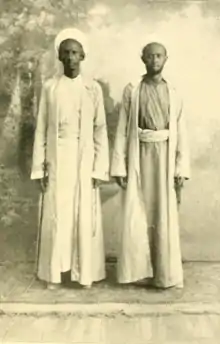Musa Abokor
The Musa Abokor (Somali: Muuse Abokor) is a Somali clan, and a major sub-division of the Habr Je'lo sub-clan of the Isaaq.[1] Historically, the Musa Abokor along with the Omar obtained much of their wealth via their frankincense plantations in the mountainous interior adjacent to the coastline, whereas the Mohamed Abokor were chiefly nomadic pastoralists.[2]
Muuse Abokor | |
|---|---|
| Regions with significant populations | |
| Ethiopia, Djibouti, Somaliland, Kenya | |
| Languages | |
| Somali, Arabic | |
| Religion | |
| Islam | |
| Related ethnic groups | |
| Other Habr Je'lo clans, and Isaaq |
Overview
The Musa Abokor are one of the largest sub-divisions of the Habr Je'lo clan family.[3] They inhabit the Togdheer, Sahil, Sanaag and Sool regions of Somaliland. They exclusively dominate the Aynabo district in Sool and El Afweyn district in Sanaag.[4][5] In addition they are also present in Isiolo, Kenya, where they form part of the Isahakia community. Major sub-divisions of the clan include Reer Yoonis, Biciide, Uduruxmiin, Bahmajeelo and Cali Barre.
History
The Habr Je’lo coastal settlements and ports, stretching from Siyara in the west to Heis (Xiis) in the east, were important to trade and communication with the Somali interior. While the settlements were not as significant as the more established ports of Berbera, Zeila and Bulhar (respectively), the principle Habr Je’lo port of Kurrum (Karin) was a major market for livestock and frankincense procured from the interior,[6] and was a favorite for livestock traders due to the close proximity of the port to Aden. Habr Je’lo traders acted as middlemen to Dhulbahante livestock herders in the interior by purchasing and/or bartering their stock for export to the Aden market:
“The last branch of the Western tribes is the Haber el Jahleh, who possess the sea-ports from Seyareh to the ruined village of Rukudah, and as far as the town of Heis. Of these towns, Kurrum is the most important, from its possessing a tolerable harbour, and from its being the nearest point from Aden, the course to which place is N.N.W., consequently the wind is fair, and the boats laden with sheep for the Aden market pass but one night at sea, whilst those from Berbera are generally three. What greatly enhances the value of Kurrum however is its proximity to the country of the Dulbahanta, who approach within four days of Kurrum, and who therefore naturally have their chief trade through that port.[7]
Soocane faction
During the early to mid 19th century the Musa Abokor, along with other sub-divisions of the Habr Je'lo, were part of a military faction known as Soocane. The faction was lead by Kite Fiqi, a military leader and poet belonging to the Reer Yoonis sub-division of the Musa Abokor.[8][9][10]
Involvement in the Dervish movement

The Habr Je’lo were one of the first clans in the Somaliland Protectrate to revolt against the Colonial government between the late 19th and early 20th centuries. Among their prominent anti-colonial ideologues during the Dervish period were Deria Arale, Deria Gure, Abdallah Shihiri, Ibrahim Boghol and Haji Sudi, the latter is credited for importing Dervish customs into the Somali peninsula as well as being one of the original founders of the Somali Dervish Movement. Moreover, the Habr Je'lo played an influential role after the demise of the Dervish Movement in 1920, with Sheikh Bashir Yussuf and Farah Omar being important anti-colonial notables.
According to the British War Office, the Musa Abokor provided significant armaments to the Dervish forces in the interior.[11] The Musa Abokor also made up a significant part of the Dervish forces, with a force of 2,000 Sa'ad Yunis and Uduruhmin Dervishes lead by Ibrahim Boghol laying siege to Las Khorey, the capital of the Warsangeli. Ibrahim's forces captured the eastern portion of the town, killing many Warsangeli fighters. The force managed to surround the settlement and capture the only source of water, causing many to die of thirst. While Las Khorey was being besieged, the Warsangeli were able to secretly send a dhow to Aden to request help from the British Navy, and on May 10 Lancelot Turton commanding the HMS Northbrook arrived at Las Khorey and commenced to shell Ibrahim and his forces with Lyddite explosives, forcing them to retreat to the mountains and thus ending the deadly siege.[12][13]
Clan Tree
- Sheikh Ishaaq Bin Ahmed (Sheikh Ishaaq)
- Muuse (Habr Je'lo)
- Abokor
- Jibril
- Abokor
- Musa
- Uduruhmin
- Idris
- Abdirahman
- Osman (Bah Majeelo)
- Abdille (Bah Majeelo)
- Isaaq (Bah majeelo)
- Yunis (Rer Yunis)
- Mohamed
- Isman
- Barre Abdirahman
- Ali Barre
- Mohamed
- Yunis
- Burale
- Bi'ide
- Musa
- Abokor
- Jibril
- Abokor
- Muuse (Habr Je'lo)
References
- Paris, Société d'anthropologie de (1884). Bulletins et mémoires (in French).
- Lewis, I. M. (3 February 2017). I.M Lewis: Peoples of the Horn of Afrcia. ISBN 9781315308173. |
- "Habar Jeclo". Hoyga Qabaayilka Reer Sheekh Isaxaaq. Retrieved 2021-01-11.
- Baradmin. "jabhada hubaysan oo beesha Muuse Abokor (Habarjeclo), ayaa gashay buuraha bariga Somaliland | Baraarugnews .net". Retrieved 2021-01-11.
- "[Breaking News:-] Taliyaha Jabhada Xaqdoon Ee Gobolka Sanaag Oo Saxaafada Hadda La Hadlay Iyo Qodobo Xasaasi Ah Oo Miiska Saaran". karinnews.net. 2020-06-22. Retrieved 2021-01-11.
- Ethnographie Nordost-Afrikas: Die Materielle Cultur Der Danakil, Galla Und Somal, 1893
- The Journal of the Royal Geographical Society, Volume 19, p. 63, 1848
- "Kite(Part1)". gabayo.tripod.com. Retrieved 2021-01-11.
- "QABAA'ILKA AY KA KOOBANTAHAY QOOMIYADDA HABAR-JICLO". Qorilugud News 24. 2018-09-27. Retrieved 2021-01-11.
- "Hoyga suugaanta". www.hoygasuugaanta.com. Retrieved 2021-01-11.
- Official History of the Operation, Volume 1. p. 41
- The Navy Everywhere, 1919. pp. 254-258
- The Sramble in the Horn of Africa. The History of Somalia (1827-1977). pp. 451-457